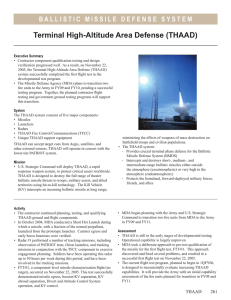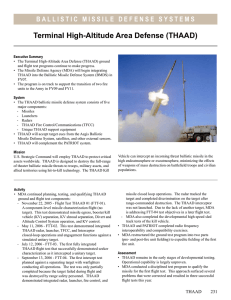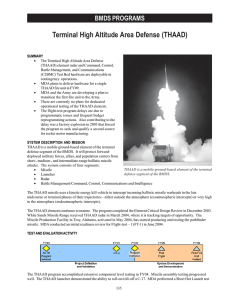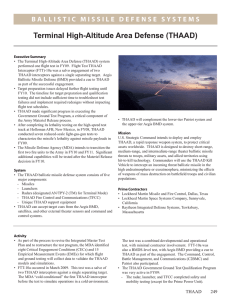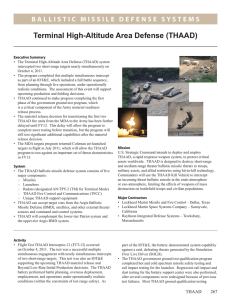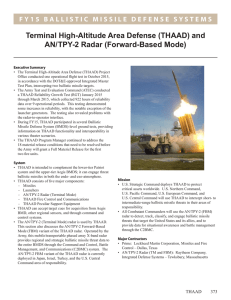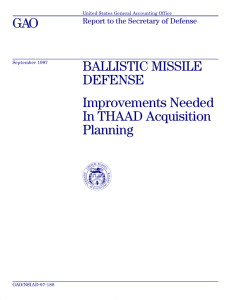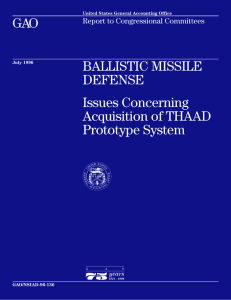Terminal High-Altitude Area Defense (THAAD)
advertisement
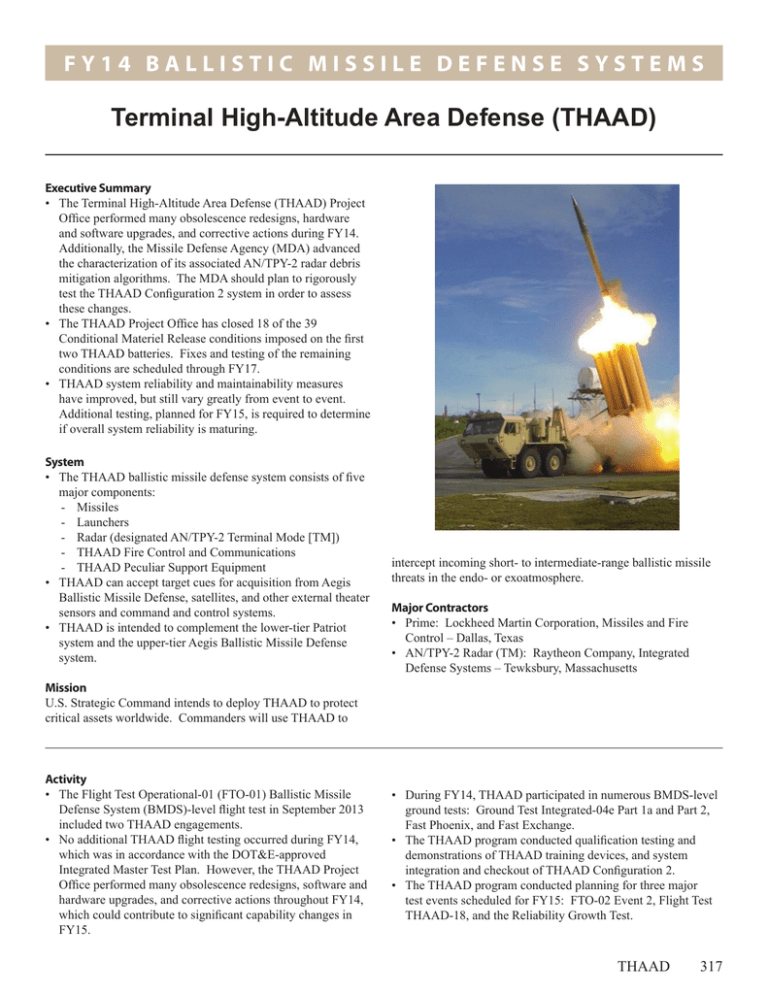
FY14 BALLISTIC MISSILE DEFENSE SYSTEMS Terminal High-Altitude Area Defense (THAAD) Executive Summary • The Terminal High-Altitude Area Defense (THAAD) Project Office performed many obsolescence redesigns, hardware and software upgrades, and corrective actions during FY14. Additionally, the Missile Defense Agency (MDA) advanced the characterization of its associated AN/TPY-2 radar debris mitigation algorithms. The MDA should plan to rigorously test the THAAD Configuration 2 system in order to assess these changes. • The THAAD Project Office has closed 18 of the 39 Conditional Materiel Release conditions imposed on the first two THAAD batteries. Fixes and testing of the remaining conditions are scheduled through FY17. • THAAD system reliability and maintainability measures have improved, but still vary greatly from event to event. Additional testing, planned for FY15, is required to determine if overall system reliability is maturing. System • The THAAD ballistic missile defense system consists of five major components: -Missiles - Launchers - Radar (designated AN/TPY-2 Terminal Mode [TM]) - THAAD Fire Control and Communications - THAAD Peculiar Support Equipment • THAAD can accept target cues for acquisition from Aegis Ballistic Missile Defense, satellites, and other external theater sensors and command and control systems. • THAAD is intended to complement the lower-tier Patriot system and the upper-tier Aegis Ballistic Missile Defense system. intercept incoming short- to intermediate-range ballistic missile threats in the endo- or exoatmosphere. Major Contractors • Prime: Lockheed Martin Corporation, Missiles and Fire Control – Dallas, Texas • AN/TPY-2 Radar (TM): Raytheon Company, Integrated Defense Systems – Tewksbury, Massachusetts Mission U.S. Strategic Command intends to deploy THAAD to protect critical assets worldwide. Commanders will use THAAD to Activity • The Flight Test Operational-01 (FTO-01) Ballistic Missile Defense System (BMDS)-level flight test in September 2013 included two THAAD engagements. • No additional THAAD flight testing occurred during FY14, which was in accordance with the DOT&E-approved Integrated Master Test Plan. However, the THAAD Project Office performed many obsolescence redesigns, software and hardware upgrades, and corrective actions throughout FY14, which could contribute to significant capability changes in FY15. • During FY14, THAAD participated in numerous BMDS-level ground tests: Ground Test Integrated-04e Part 1a and Part 2, Fast Phoenix, and Fast Exchange. • The THAAD program conducted qualification testing and demonstrations of THAAD training devices, and system integration and checkout of THAAD Configuration 2. • The THAAD program conducted planning for three major test events scheduled for FY15: FTO-02 Event 2, Flight Test THAAD-18, and the Reliability Growth Test. THAAD 317 FY14 BALLISTIC MISSILE DEFENSE SYSTEMS • The Army reviewed and assessed reliability and maintainability data from the FTO-01 flight test. Assessment • The classified DOT&E February 2014 BMDS Annual Report, Appendix E, assesses the results from the FTO-01 mission and includes six key findings covering THAAD participation and system-level performance, effectiveness, and suitability. • During ground tests in FY14, THAAD exercised debris mitigation algorithms, advancing the characterization of this key component of THAAD Configuration 2 capability. However, flight testing will be required to complete the characterization. • The THAAD program continued efforts to achieve a Full Materiel Release of the first two THAAD batteries, which achieved Conditional Materiel Release in February 2012. The THAAD Project Office continued to address the 39 conditions that need to be resolved before the Army could grant a Full Materiel Release. Fixes and testing of the 21 open conditions are scheduled through FY17. In addition to the 7 conditions closed in FY12 and FY13, 11 were closed in FY14: - Verification of technical manuals - Hazard classification for missile transport - A safety review of the technical manuals - Verifying missile non-operating performance requirements in cold environments - Verifying the missile Thermally Initiated Venting System in a flight test - Correcting common datalink messaging issues for Precision Position Location Information message generation and receipt - Changing contingent lethal object logic in the fire control - Safety verification of insensitive munitions requirements - Implementing configuration control for software and firmware management - Resolving radar software message problems with fixes installed in fielded batteries - Completing missile field and storage maintenance and inspection procedures 318 THAAD • Comparing the reliability and maintainability data from FTO-01 to the previous results from Flight Test Integrated-01 (1QFY13), Flight Test THAAD-12 (1QFY12), and the Reliability Confidence Test (4QFY11) shows that reliability and maintainability measures are still fluctuating greatly between test events. FTO-01 results were generally improved from Flight Test Integrated 01, but given the differences between events, data from a longer, operationally realistic test event such as the upcoming Reliability Growth Test in FY15 are needed to determine if the overall system reliability is maturing. Recommendations • Status of Previous Recommendations. - The classified DOT&E February 2012 THAAD and AN/ TPY-2 Radar Operational and LFT&E Report contained 7 recommendations in addition to and not associated with the original 39 Conditional Materiel Release conditions established. Two recommendations have been addressed. The MDA should continue to address the remaining three classified recommendations (Effectiveness #2, Effectiveness #5, and Survivability #4). In addition, the MDA and the Army should conduct electronic warfare testing and analysis (Suitability #3) and implement equipment redesigns and modifications identified during natural environment testing (Suitability #11). - DOT&E made one additional recommendation in FY13 for the THAAD Project Office to reassess their reliability and maintainability growth planning curve. Progress was made on this recommendation; however, it was hampered by THAAD component configurations remaining in flux. • FY14 Recommendation. 1. The MDA should plan to rigorously test the THAAD Configuration 2 system in order to assess obsolescence and other redesigns of hardware and software.
